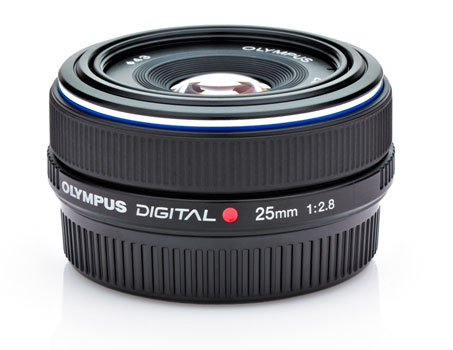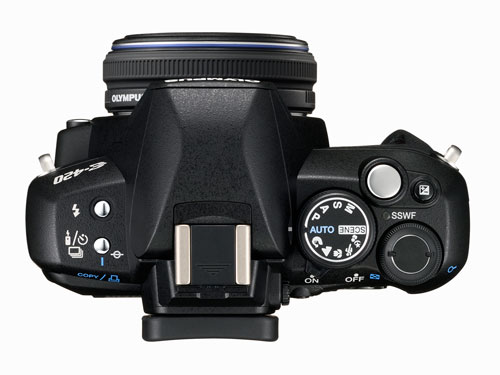Olympus E-420: World's Smallest Digital SLR
by Wesley Fink on March 5, 2008 6:00 PM EST- Posted in
- Digital Camera
E-420 Lenses

A new tiny 25mm f2.8 pancake lens will also launch with the E-420. The lens is very reminiscent of the pioneering Pentax 40mm f2.8. It is offered as a kit option for the E-420. The focal length of 25mm is the 35mm equivalent of 50mm on the 4/3 sensor since the lens factor is 2X, instead of the 1.6X/1.5X common with competing APS-C sensors.

As you can see from this top view, the E-420 with the 25mm lens is truly small enough to fit in a small purse or a large pocket. The E-420 is also available with the 14-42mm (28-84mm equivalent, left below) zoom lens, which is the smallest and lightest kit zoom you can buy at 65.5mm diameter by 61mm length and a weight of 190g.

For the past 6 months two of the great kit values on the market have been the two-lens E-410 or E-510 kits. Both included the 14-42mm (left) and 40-150mm (center) lenses which have shown excellent quality in performance testing. Olympus has not announced a similar two-lens kit version of the E-420, but the 40-150mm (80-300mm equivalent) telephoto zoom is available separately.
Like the diminutive 14-42mm, the 40-150mm is the smallest and lightest lens in its class at 220g with a diameter of 65.5mm and a length of 72mm. Another Olympus record holder for smallest lens is the 35mm (70mm equivalent, right) f3.5 macro lens with a street price of $199. This tiny macro lens goes to true 1:1 macro without any extension tubes or special lenses (2X life-size 35mm equivalent) but weighs just 165g and is only 53mm long.
The new E-420 will mount any Olympus Digital lens or any 4/3 lens from Leica, Panasonic or Sigma. Some Leica zooms lenses also include Optical Image Stabilization which should work fine on the new E-420. It should be clear, however, that Olympus has both the camera body and lens options to allow those interested in a truly compact Digital SLR system to put together an amazingly small but complete DSLR system.










16 Comments
View All Comments
Wesley Fink - Thursday, March 6, 2008 - link
The Olympus auto sensor cleaning is regarded by most as the most effective available in DSLR cameras, so dust is hardly a concern. I do not understand your lens point since the 14-42 (28-84), 40-150 (80-300), and 35 (70) macro are all three the smallest and lightest lenses in their class, and optically quite excellent. Now there will also be a tiny 25mm (50) pancake lens as a kit choice.I do agree the E-420 would be better with body integral IS and an updated AF system with more points, but it is certainly competitive at its selling price. The E-420 is not a camera for everyone, but for those who really want a tiny DSLR camera and system it is one of the few options available.
haplo602 - Sunday, March 9, 2008 - link
well it's good to know that the Oly sensor cleaning is one of the best, but a closed P&S system does have NO dust worries, so no reason to pay for the extra parts.as to the lenses, yes they might be small and good, but you still need to carry them and change them as needed. this kind of defies the minimal size and weight of this SLR. P&S has the same size and weight minus the lens hassle (ofc it is limited to only one lens).
and to reply to the poster about the sensor size. I do not think the 4/3 sensor size is that much a win if you are climbing 10+MP.
Samus - Thursday, March 6, 2008 - link
This camera, like the Celeron 420, daftly targets the 4:20 crowd ^_^Johnmcl7 - Wednesday, March 5, 2008 - link
It was actually the E-330 which has the dubious honour of being the first Olympus SLR with the digital image stabilisation scene mode. Also it's worth bearing in mind that the E-400 and E-410 are actually more different than they perhaps seem, the E-400 was a bit of a 'test' camera only released to Europe with a Kodak 10MP CCD sensor, no liveview and some other missing features such as no mirror lockup. The E-410 uses a Panasonic 'NMOS' sensor, has liveview, mirror lockup and some other small touches. Irritatingly all the E-4xx cameras lack the ISO/EXP/WB/AF selection on the rear d-pad which their E-5xx siblings have.Pleased to see Olympus produce a 25mm pancake lens as there's no doubt that there's a market for small and light DSLRs. Hopefully if this does well we'll see some more pancake lenses as 14mm is the one I'm wanting. While I like the E-3 I definintely think there's a market for a pro-spec body around the size of the E-4xx - while there'd need to be some compromises it would appeal as a second camera for other system owners (particularly 35mm Nikon/Canons) rather than trying to take market away as they have tried with the E-3.
John
Wesley Fink - Wednesday, March 5, 2008 - link
I did not realize the E-330 pioneered the Digital Image stabilization feature. As you allude the in-body mechanical IS would have been a more desirable choice IMHO. I have corrected the reference.pervisanathema - Wednesday, March 5, 2008 - link
IB camera snobs